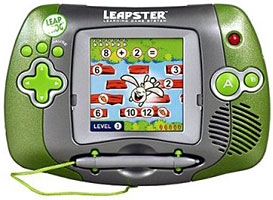Learn Everywhere Leapster
Feedsee Toys : Learn Everywhere Leapster : Leapfrog multimedia learning system
 Portable interactive system with action-packed games is focused on learning essentials for preschool to fourth grade, comes with two built-in games, and is expandable with modules that teach phonics, spelling, math, art, and music. The Leapster Learning Game System applies intelligence-increasing principles to a video-game format. Each game offers multiple skill levels so kids can ease into new territory at the beginner level and challenge themselves with more advanced learning problems as they understand the concept.
Portable interactive system with action-packed games is focused on learning essentials for preschool to fourth grade, comes with two built-in games, and is expandable with modules that teach phonics, spelling, math, art, and music. The Leapster Learning Game System applies intelligence-increasing principles to a video-game format. Each game offers multiple skill levels so kids can ease into new territory at the beginner level and challenge themselves with more advanced learning problems as they understand the concept.
Evolution of Educational Games
Educational games have come a long way, evolving alongside technological advancements and pedagogical insights. From simple board games to sophisticated digital platforms, they have consistently aimed to make learning engaging and enjoyable. Here's a look at their progression:
- Board and Card Games: Long before the digital age, traditional board and card games like "Monopoly" and "Memory" were used to teach concepts such as money management, memory skills, and strategic thinking.
- Early Computer Games: The 1970s and 1980s saw the introduction of computer-based educational games. Classics like "The Oregon Trail" and "Number Munchers" combined learning with gameplay, teaching history, math, and problem-solving.
- Edutainment Boom: The 1990s witnessed the "edutainment" era, where titles like "Zoombinis", "Reader Rabbit", and "Math Blaster" became popular. These games seamlessly blended entertainment with educational content, making learning fun.
- Internet and Online Games: With the rise of the internet in the 2000s, online educational platforms and games emerged. Websites like Coolmath and Starfall offered a variety of subject-specific games for different age groups.
- Interactive and Immersive Games: Advancements in graphics and interactivity led to more immersive educational games. Platforms like "Minecraft: Education Edition" allowed students to build and explore virtual worlds, fostering creativity and collaboration.
- Mobile Learning Games: The proliferation of smartphones and tablets brought educational games to the fingertips. Apps like "Duolingo" and "DragonBox" provided on-the-go learning experiences in languages, math, and more.
- Virtual and Augmented Reality: Recent years have seen the integration of VR and AR in educational gaming. These technologies offer immersive experiences, from exploring the human body in 3D to virtually visiting historical sites.
- Adaptive and Personalized Gaming: Modern educational games use AI to adapt content based on individual learner profiles, ensuring a more personalized and effective learning journey.
As educational games continue to evolve, they remain a testament to the idea that learning can be both fun and effective, adapting to the needs and interests of each generation.